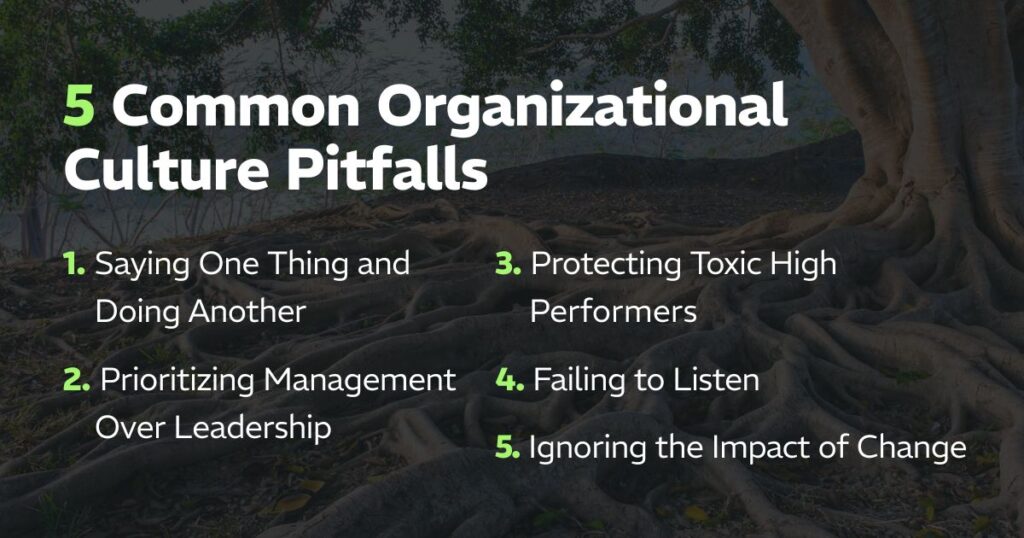Organizational culture and leadership are inseparable. One cannot thrive without the other.
Right now, many organizations are experiencing what I call a culture crisis. Employees feel disconnected. Managers are overwhelmed. Burnout, stress, and disengagement are no longer exceptions. Instead, they’re part of everyone’s daily reality. And when culture suffers, so do innovation, adaptability, contribution, and growth.
That’s why leadership matters more than ever. Every decision, every conversation, every action made by a leader shapes how people experience work. When leadership and culture align, trust grows, engagement thrives, and performance follows. When they don’t, the disconnect shows up fast in morale, retention, and results.
Culture is the sum of how everyone in an organization shows up every day. But it’s leaders who set the tone. And in a culture crisis, human-centered leadership becomes the antidote.
What Is Organizational Culture?
Organizational culture is the shared values, beliefs, and behaviors that shape how work gets done and how people experience your company. It’s what employees feel when they show up every day — and what customers feel when they interact with your brand.
In a culture crisis, those experiences start to shift. Disconnection shows up in subtle ways: collaboration feels harder, decisions take longer, and leaders struggle to adapt with clarity. Over time, that erosion impacts performance, trust, and growth.
Culture shows up in everything, including:
- Who gets hired and promoted.
- How decisions get made.
- How leaders respond to challenges and change.
The question isn’t whether you have a culture — every organization does. The real question is whether your culture is strong enough to sustain innovation, contribution, and performance in the face of today’s challenges.
How Does Leadership Influence Organizational Culture?
Culture is never just an abstract idea. It’s modeled by leaders every day in the way decisions are made, how conflict is handled, and what behaviors are rewarded. Culture is shaped more by actions than intentions.
In the middle of a culture crisis, that leadership influence becomes even more visible. When leaders show up with clarity and consistency, people feel safe, supported, and engaged. When leaders fall back on control, inconsistency, or silence, trust erodes quickly. The gap between what’s written on the wall and what’s lived in the hall widens and employees feel it.
This is why human-centered leadership is so important. Leaders who practice empathy, transparency, and emotional intelligence create environments where people feel valued, heard, and inspired to contribute. They model trust and give permission for their teams to do the same. That consistency turns culture from words into lived experience.
The way leaders lead determines the culture they get. And in a culture crisis, human-centered growth isn’t optional — it’s the difference between compliance and commitment, between erosion and growth.
Why Organizational Culture Is a Competitive Advantage
A strong culture is a business multiplier. In the middle of a culture crisis, the organizations that sustain trust, adaptability, and belonging pull ahead. Here are three powerful ways a strong organizational culture benefits your business.
Drives Measurable Performance
Culture impacts the bottom line and how the market perceives your organization. Korn Ferry reports that two-thirds of executives from the World’s Most Admired Companies attribute at least 30% of their company’s market value to culture, with one-third attributing at least 50% to culture.
Companies in the top quartile for engagement, which is closely tied to strong culture, deliver 23% higher profitability and 18% greater sales productivity than those in the bottom quartile, according to Gallup research. In a culture crisis, the difference between engaged and disengaged teams shows up quickly in the numbers.
Improves Retention and Reduces Risk
In a culture crisis, people leave. And when they do, knowledge, momentum, and trust walk out the door with them. Strong cultures build loyalty, reduce turnover, and create stability through change, protecting the human capital that makes growth possible.
Fuels Innovation and Agility
Disruption exposes culture. High-trust environments give employees the psychological safety to share ideas, take smart risks, and adapt quickly. That adaptability is what keeps organizations innovating when conditions change.
The through line? Human-centered leadership strengthens culture, and strong culture drives results. If you want better business outcomes, start with people.

Common Culture Pitfalls (and How to Avoid Them)
Even well-intentioned leaders can stumble when shaping organizational culture. In the middle of a culture crisis, these mistakes accelerate disengagement, erode trust, and undermine performance. Here’s how each common pitfall shows up — and what to do instead.
Saying One Thing and Doing Another
Nothing erodes trust faster than inconsistency. When leaders promote values they don’t live, employee trust plummets. Performance suffers, productivity declines, and absenteeism soars. By contrast, leaders who are consistent in their words and actions build their credibility and encourage trust at scale.
Prioritizing Management Over Leadership
Managing tasks isn’t the same as inspiring people. Leaders who focus solely on control miss the opportunity to build clarity and connection. Highly engaged teams are led, not managed, and they turn their enthusiasm into higher productivity and better business outcomes.
Make the shift from supervision to vision. In a culture crisis, employees need clarity and purpose more than ever. Empower them to deliver by focusing on meaning, not micromanagement.
Protecting Toxic High Performers
Top performers who disregard values can damage morale and derail culture. McKinsey research highlights how cultures with strong behavioral norms outperform peers in long-term growth and resilience during a crisis. Don’t compromise culture for short-term numbers; hold everyone accountable to both performance and principles.
Failing to Listen
When employees feel unheard, engagement plummets. Listening drives innovation and loyalty. Only 25% of employees believe their voice matters at work, according to Gallup. Be the exception by creating structured listening systems and responding visibly to feedback. Doing so will reinforce trust and inclusion while giving employees a path to contribution, a critical differentiator in a culture crisis.
Ignoring the Impact of Change
New technologies, restructuring, and market disruptions all impact culture. Leaders who fail to recalibrate can find themselves battling disengagement and high attrition. During change, communicate clearly, reinforce purpose, and adapt rituals to maintain connection and performance.
Avoiding these pitfalls requires intention — and leading through the lens of humanity. Human-centered leadership is the antidote to cultural drift.

Building Culture Through Leadership: The Human-Centered Growth Framework
In a culture crisis, leadership can’t be left to intention or instinct. Leaders need a framework that creates clarity, connection, and trust — especially when people feel overwhelmed or uncertain. That’s the purpose of the Human-Centered Leadership model, built around three commitments.
1. Start With Self: Align Who You Are with How You Lead
Culture begins with self-awareness. Leaders who pause to reflect on their impact — through values, vision, and daily habits — create stability in uncertain times. When words and actions align, trust follows.
In a culture crisis, employees look first to whether leaders show up consistently. Self-leadership builds the foundation of credibility and confidence that teams rely on.
2. Connect in Service: Build Trust and Belonging
At the team level, culture is rooted in connection. Leaders who listen deeply, invite input, and co-create expectations foster trust and shared ownership. Coaching for growth and recognizing contribution reinforces belonging.
When teams feel seen and supported, they respond with engagement, loyalty, and performance, which is exactly what’s needed to move through crisis.
3. Create Momentum Through Harmony: Lead With Emotional Intelligence
Great leaders don’t just manage tasks; they calibrate energy. Emotional intelligence allows leaders to manage their own intensity, surface honest conversations, and turn tension into forward motion.
In complex environments, this is what sustains momentum. Emotional intelligence creates psychological safety, helping people feel safe enough to contribute and accountable enough to deliver.
Together, these commitments create a culture strong enough to withstand crisis and resilient enough to grow. When leaders lead with clarity, consistency, and care, they turn culture into a catalyst for performance and progress.
What’s Next: Lead the Change
The culture crisis won’t resolve on its own. How your people experience work tomorrow depends on the leadership decisions you make today. This is the moment to align leadership strategy with the culture you want to create — and take the first step toward lasting change.
Start by downloading the Human-Centered Growth Playbook. Inside, you’ll find a practical, people-first model for building high-performance teams, strengthening culture, and leading through complexity with clarity, connection, and purpose.



![[RYAN] Featured_Leadership Development Planning for Human Centered Growth Group climbing a hill together](https://ryanestis.com/wp-content/uploads/bb-plugin/cache/RYAN-Featured_Leadership-Development-Planning-for-Human-Centered-Growth-1024x538-panorama-ba61edeb5d6c961b544c5c7916ed5ca0-.png)






